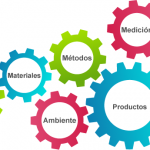Software Solutions MRP, ERP, SCM and APS: differents but complementary (I)
The global business world is complex. Organizations of all sizes generally work with more than one software, and they must be integrated together in order to better support and optimize all processes.
Industrial companies which deal with their production’s planning and scheduling usually use multiple solutions: enterprise resource planning (ERP), material needs planning (MRP), supply chain management (SCM) and production advanced planning and scheduling (APS), always with the aim of optimizing the processes of manufacture and distribution. Each solution has its own characteristics and functions, but there is a defined overlap between them.
In this post, we will explain what the APS, SCM, ERP and MRP solutions consist of.
What is APS Software?
The APS software is a decision support mechanism for logistics and manufacturing processes. Its main objective is to provide the best possible solution for planning or scheduling, based on an analysis for orders, demand, supply, capacity and logistics.
An APS system allows a quick reaction to market changes, better performance and delivery times, optimized inventory levels and better customer service, which reduces costs.
However, an APS software does not replace other systems; it is an aggregate system at the top. Actually, It is a subset of optimization of an SCM software. It takes into account specific restrictions (a broken machine, limited capacity, a strike, etc.) and quickly analyzes the simulation data to obtain optimized recommendations.
What is an SCM solution?
The SCM manages multiple business processes in the supply chain, starting from product planning and ending with delivery. This system helps organizations to develop processes that integrate their manufacturing activities with logistics.
Its main objective is to manage the flow of information between buyers, suppliers, production, warehouse and logistics: traceability. It is responsible for providing end-to-end visibility in each supply chain network’s component without losing sight of the company’s short and long-term objectives.

What is an ERP system?
In basic terms, an ERP system is a business software that integrates several administrative functions, from finance to human resources (HR) to manufacturing and sales. ERP manage the resources of the entire company and reconcile all financial transactions. It is designed around multiple commercial functions, which means that the modules communicate with each other through a central database and the information between departments is shared.
What is an MRP solution?
Another term that is often used when talking about ERP is MRP. Most of the manufacturers use this organization system: the software for materials planning needs (MRP) that allows the planning, the scheduling and the general materials control used in manufacturing process.
ERP systems integrate the maintenance of standardized records such as MRP solutions, but their main function is to allow the exchange of information between many disparate areas of an organization, which allows a cohesive vision of organization functioning.
In this comparative table you will see the main characteristics in relation to the planning for each of the solutions:
| APS | SCM | ERP |
Planning method | Dynamic | Dynamic | Static |
Data | Fast | Medium | Fast |
Decisions support | It says what | It says what | It says what |
Frequency of data update | Real | Real | Lots of data |
Main focus | Manufacturing simulation for delivery processes | Simulation of the demand for | Data management and its integration |
R estrictions Management | Simultaneus | Simultaneus | Isolated |
Analysis model | Focus from the bottom | Focus from the bottom | Focus from top to bottom |
Optimization | High | High | Slow |
Planning periods | Numerous | Numerous | Unique |
Approach to planning | Planning with or without restrictions | Planning with restrictions | Capacity-based planning with limited restrictions |
Method of calculation | Heuristic, optimization, algorithms | Heuristic | MRP calculation |
Source: Technology Evaluation Centres
In our next post we will explain how these solutions differ and how they complement each other in a productive process.
And you, what systems or solutions do you use to manage your production and supply chain?
To be continued…





